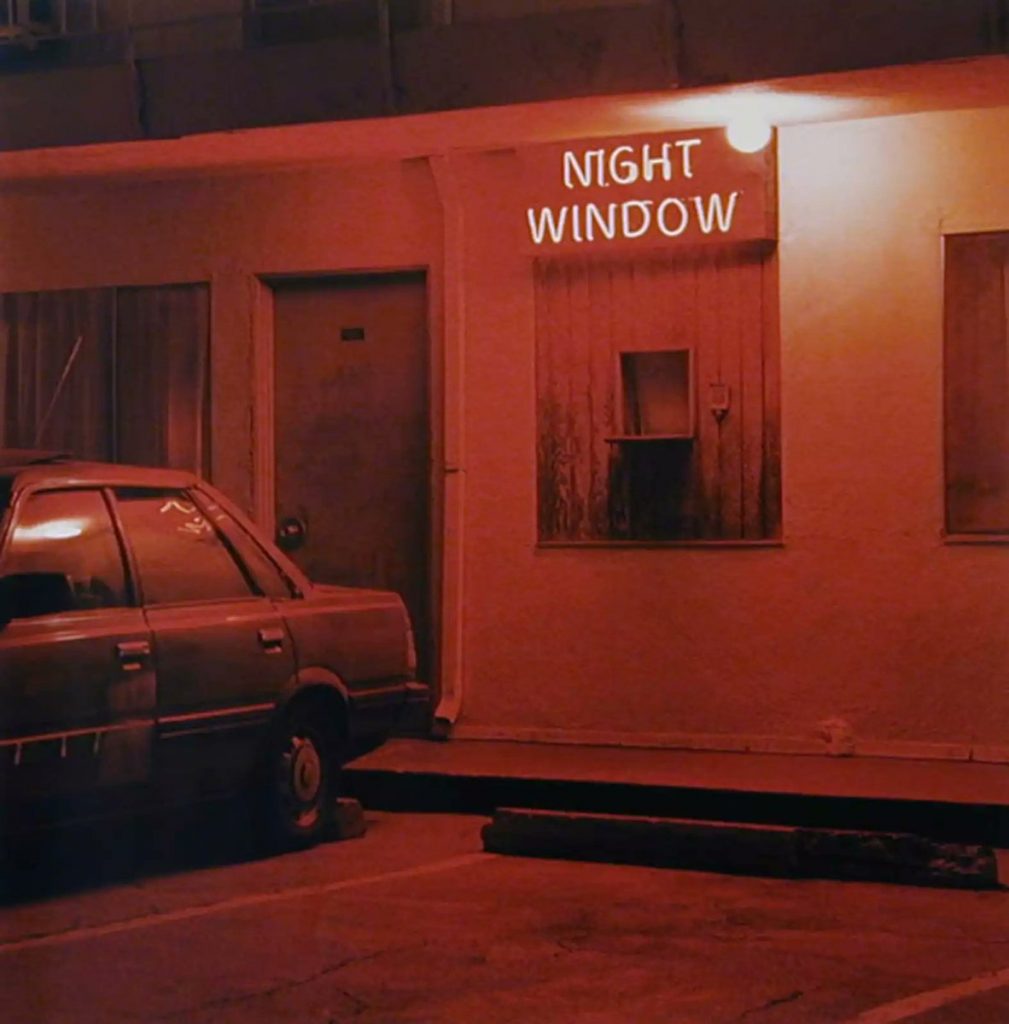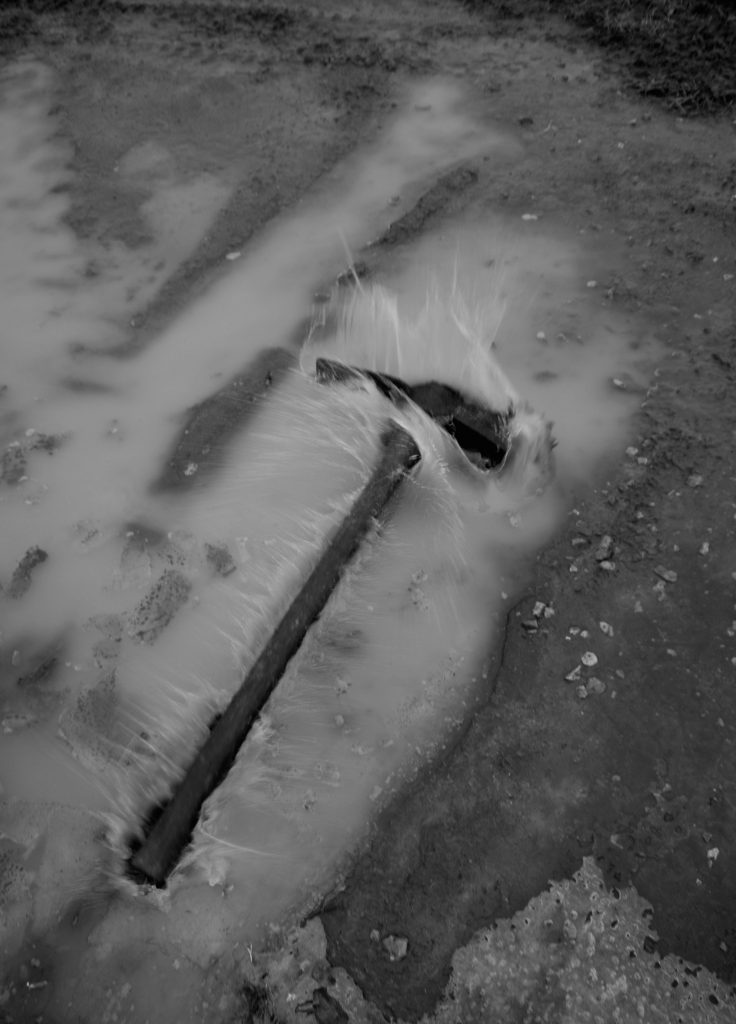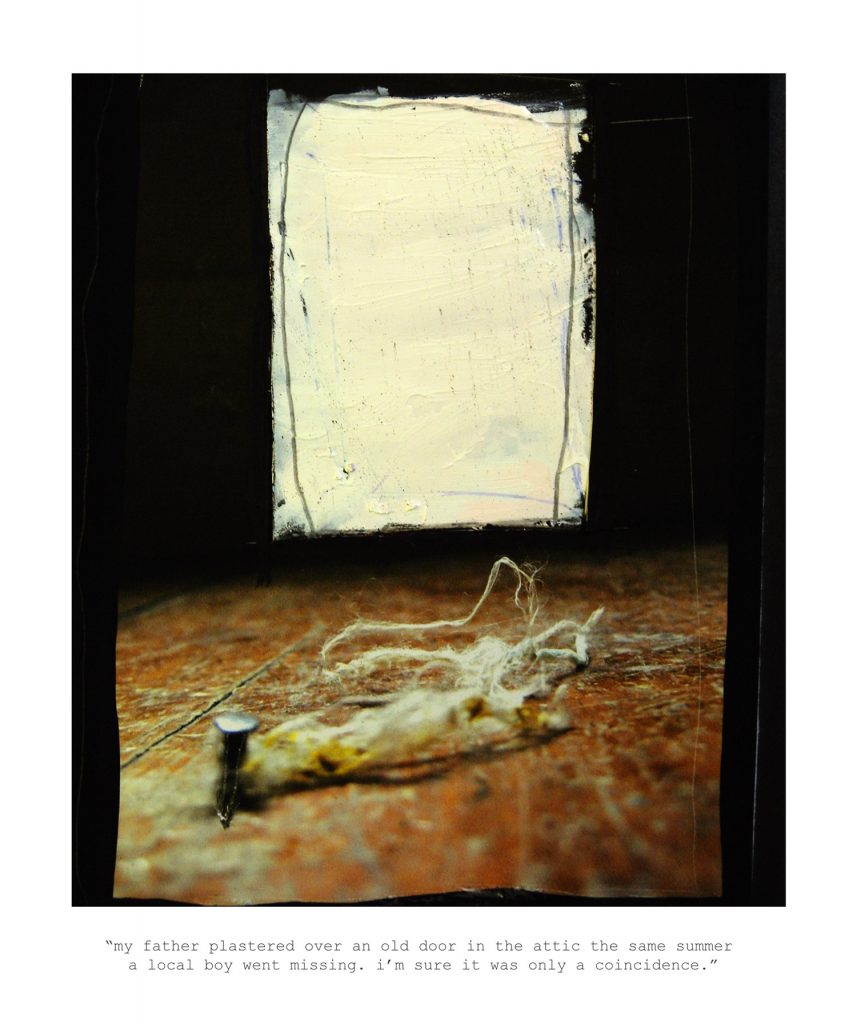In: American photographers

Jeff Brouws | Night Window, Los Angeles, California, 2000
December 29, 2023Jeff Brouws | Night Window, Los Angeles, California, 2000
In the Far West, where Brigham Young ended up and I started from, they tell stories about hoop snakes.
When a hoop snake wants to get somewhere—whether because the hoop snake is after something, or because something is after the hoop snake—it takes its tail (which may or may not have rattles on it) into its mouth, thus forming itself into a hoop, and rolls.
Jehovah enjoined snakes to crawl on their belly in the dust, but Jehovah was an Easterner. Rolling along, bowling along, is a lot quicker and more satisfying than crawling. But, for the hoop snakes with rattles, there is a drawback. They are venomous snakes, and when they bite their own tail they die, in awful agony, of snakebite. All progress has these hitches. I don’t know what the moral is. It may be in the end safest to lie perfectly still without even crawling. Indeed it’s certain that we shall all do so in the end, which has nothing else after it. But then no tracks are left in the dust, no lines drawn; the dark and stormy nights are all one with the sweet bright days, this moment of June—and you might as well never have lived at all.
(Ursula K. Le Guin, from her essay It was a dark and stormy nigh ; or, why are we huddling about the campfire?, 1979)
A number of the images that I share in the main page for this post are also from Brouws’ American West series (1990 – 1993) and the Highway | Approaching Nowhere series. Many of Brouws’ series seem to bleed into each other, or one body of work grows into the next in a manner that does not so much interrupt his ideas as expand them.
I have a certain affinity for abandoned and derelict spaces. I do live in the rust belt wonderland of Niagara, and before that a similar zone in Windsor and Detroit (hence my appreciation of Dave Jordano‘s fine photographs), and my time on the Canadian prairies (with ghost towns in ‘next year’s country’, as captured eerily and evocatively by Danny Singer, for example) fed that interest in an overlapping manner. Brouws’ aesthetic is akin to some past Curator’s Picks I’ve featured : The Great Texas Road Story perhaps being the most immediately similar. But Brouws’ works are less despairing, with the frequency of the neon inviting glow amidst the wastelands, but like many other artists whose work I’ve featured, historical and social themes and concerns are informed by, and informing, his scenes.
“Feelings of isolation colour my photographs – that’s what you’re sensing. It’s fascinating: what’s in your mind, heart and soul gets telegraphed onto the film plane and embedded in the photograph. It can’t be avoided.”
From the Robert Koch Gallery :
“Jeff Brouws photographically explores the American cultural landscape in its myriad of facets. A self-described “visual anthropologist” with a camera, Jeff Brouws utilizes a constructed narrative and typological approach in the making of his work. Over a span of thirty plus years, Brouws has employed a diversity of themes in his work: the American highway, the franchised landscape, deindustrialized inner city zones, as well as riffing on and re-examining bodies of work by luminary artists such as Ed Ruscha, and Bernd and Hilla Becher. Brouws captures the unique cultural experience of Americana and its iconography, visually documenting a vibrant travelogue through the half-experienced, half-remembered landscape of America’s fading culture. Directing his lens toward these temporary obsolete and abandoned sites of American consciousness, he powerfully transforms images of history and dereliction into contemplative and at times humorous commentary on the collective and expressive experience of the American landscape.”
An insightful conversation with the artist can be enjoyed here. When I first encountered Brouws’ work – the primary image in this essay Night Window, Los Angeles, California, 2000 – the quote from Le Guin that opens this meditation on his work came immediately to mind. It’s all about telling stories, some of which are quieter than others, some of which are on the verge of being forgotten and some that we may never have considered. The term ‘into the west’ has connotations both positive and negative, but that is just life, and history, and Brouws’ images encapsulate all these contradictions with an eye for beauty in what might be banal, but definitely resonates with the viewer on multiple levels.
~ Bart Gazzola
Read More
Adrianna Ault & Raymond Meeks | Ohio Farm Auction
December 11, 2023Adrianna Ault & Raymond Meeks | Ohio Farm Auction
The crops we grew last summer weren’t enough to pay the loans
Couldn’t buy the seed to plant this spring and the Farmers’ Bank foreclosed
Called my old friend Schepman up, to auction off the land
He said, “John it’s just my job and I hope you understand”
Hey, calling it your job ol’ hoss, sure don’t make it right
But if you want me to I’ll say a prayer for your soul tonight
(John Mellencamp, Rain on the Scarecrow)
One generation passeth away, and another generation cometh: but the earth abideth for ever. (Ecclesiastes 1:4, KJV)
There’s a memento mori quality to the scenes from the Ohio Farm Auction series. This may be an interpretation informed by several of the other bodies of work by Adrianna Ault (such as her series Levee which led me to the collaborative Ohio Farm Auction series), that are permeated by a sense of mortality and remembrance, as expressed in her writings about those images.
Though these images are not completely empty of people, the more striking and – unsurprisingly – starker moments that stay with you have no figures within them, though their absence and implication is powerful. The line I quote above, in response to this work came to mind immediately upon seeing the Township photos. Mellencamp’s album was a series of laments for a way of life lost (perhaps taken away or relinquished), as the world moves on (this last being closest, I feel, to the artists’ position here, with a gentle consideration of family history and generational change. Township reads more about releasing than resistance..)
The biblical quote came to me in a more indirect manner. Having recently read George Stewart’s post apocalyptic book Earth Abides (from 1949, so it ages poorly, in many ways – or this is perhaps a corolary to the ‘change’ implicit in the story presented in Ohio Farm Auction, of a time to gather and a time to discard), the ideas, again, of what is lost and our – humanity’s – place in the larger narrative of the earth was a further consideration when I engaged with these photographs…
The words of Adrianna Ault, speaking of this collaboration with Meeks (one of a number they’ve done) :
“These photographs were taken one February day in a rural township in Ohio. My partner, Raymond Meeks, and I photographed and watched as all the possessions of my family’s farm was auctioned to the highest bidder. Photographing served as a testimony to the life and work of over one hundred years of farming in my family. This work was published as a collaboration with Tim Carpenter and Brad Zellar in the book Township published by TIS books and later nominated for the 2018 Kassel Fotobookfestival Award.”
That collection of words and photographs has been described as a “careful deliberation on transience and the ultimate meaning of a way of life in the Midwest.”
More of Ault’s work can be seen here and more of Meek’s work can be seen here.
~ Bart Gazzola
Read More
Gerald Slota | Home Sweet Home | 2010
October 30, 2023Gerald Slota | Home Sweet Home | 2010
(in collaboration with Neil LaBute)
Welcome to the midnight America, the one that exists parallel to the “real” world. It’s a dark country, one where men with hooks haunt Lover’s Lane and scarecrows walk on moonlit nights. It’s the place where people go when they slip into the cracks between light and darkness, a world of routewitches and oracles, demons and ambulomancers.
The rules are different here, and everyone’s playing for keeps. Be careful. Be cautious. And listen to the urban legends, because they may be the only things that can save you from the man who waits at the crossroads, hunting souls to keep himself alive.
Welcome to the ghostside.
Home Sweet Home is a collaboration between Gerald Slota and playwright Neil Labute. Introduced to each other in 2008, they began corresponding and working together (via email, for the most part, as they did not actually meet in person until – fittingly – an exhibition of this work in New York City in October 2010.) From the statement about Home Sweet Home : “For the first time Slota’s visual narratives are aligned alongside written narratives. The series title serves as an ironic reference to much of the early material’s dark focus on themes of home and family.”
The world that Slota and LaBute present us with is the descendant – a successor, in some ways – of the sites and landmarks from Michael Lesy’ The Wisconsin Death Trip. Denizens of a desperate world, sometimes leading lives of ‘quiet desperation’ (but not always, as secrets fester and explode, unable to be contained forever, just as some of the ‘narrators’ of these images must share what they have held inside….)
I also interpret these as postcards from the characters in Harmony Korine’s infamous film Gummo (1997) : a ‘loose narrative follows several main characters who find odd and destructive ways to pass time, interrupted by vignettes depicting other inhabitants of the town.’ That descriptor could apply to Home Sweet Home as well as Korine’s experimental film….
LaBute – whose words offer an unsettling nuance and depth to Slota’s images here – has also observed that “we humans are a fairly barbarous bunch”…..
This isn’t a new concept—the idea that stories change things, rewrite the past and rewrite reality at the same time…
The true secret of the palimpsest skin of America is that every place is different, and every place is the same. That’s the true secret of the entire world, I’d guess, but I don’t have access to the world. All I have is North America, where the coyotes sing the moon down every night, and the rattlesnakes whisper warnings through the canyons.
The true secret of the skin of America is that it’s barely covered by the legends and lies that it clothes itself in, sitting otherwise naked and exposed.
More of Gerald Slota’s work can be enjoyed here. Slota was also a recently featured Artist You Need To Know from AIH Studios’ continuing series : that can be enjoyed here.
All italicized quotes are from Seanan McGuire‘s books Sparrow Hill Road (2014) and Girl in the Green Silk Gown (2018) from her Ghost Road series. In these stories the urban legend of ‘Resurrection Mary‘ is told from the point of view of the dead girl Rose Marshall who’s been wandering the highways and back roads of a ‘secret’ United States of America since her death in 1952….
~ Bart Gazzola
Read More
Mimi Plumb | The Golden City, 1984 – 2020
February 2, 2023Mimi Plumb | The Golden City, 1984 – 2020
So this is where the Renaissance has led to | And we will be the only ones to know
So take a drive and breathe the air of ashes | That is, if you need a place to go
If you have to beg or steal or borrow | Welcome to Los Angeles, City of Tomorrow
(Phil Ochs, The World Began In Eden And Ended In Los Angeles)
When I first encountered Plumb’s images, that song from the late Phil Ochs came to mind: it seems upbeat and pleasant but is, in fact, nuanced with a despair that is subtle but builds (and I will admit my interpretation may be coloured by his suicide. But the rendition of that song I am familiar with is a live version, and Ochs talks at the beginning of his fascination with Los Angeles “which intrigues me like a sensual morgue.” Plumb’s works have a certain sterility, to them, as well, that intersects with this consideration).
As with Plumb’s scenes, there’s more at play than the obvious. Considering that California exists in imaginations just as vividly – if not always accurately – as any seminal ‘place’ like ‘Siberia’, Plumb’s photographs invite us to construct narratives around them, that build, converge or perhaps complete what she intends, with her own personal stories….
I will admit that when looking at Mimi Plumb’s photography, that The Golden City often blended with another body of work of hers, titled The White Sky. I doubt that the artist would be offended by that, as the elements of memory, nostalgia and social realism suffuse her practice, and are themes that are present in her artwork still. Although her narrative is a personal one, it also has elements that are more universal, when considering larger tropes that her work touches upon.
“The Golden City [is] a series of images that frames subjects against the sprawling backdrop of San Francisco. Similar to Plumb’s other bodies of work, The Golden City is an ode to an earlier America—a rich and playful elaboration on the human condition, and its tendencies towards hedonism and spectacle. To say that this work largely references the exploitation of the natural world on account of humans would be reductive. While sculptural detritus and empty construction sites set the groundwork for this series, Plumb flips dramatic irony on its head by capturing subjects enthralled by events transpiring just beyond the frame. We are not in on the comings and goings within this world, but are sucked in nonetheless; left only with a sense of wonder at what could be bringing about such awe.” (from Document, with an engaging conversation with Plumb you can read as well)
Much more of Plumb’s work – from this series and a number of others – can be seen here. If you’d like to listen to her talk about her work, the Museum of Contemporary Photography has a video you can enjoy here.
Plumb published a book of selected images from this body of work with Stanley/Barker books in 2022.
~ Bart Gazzola
Read More
Recent Comments